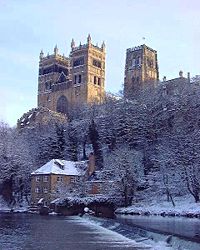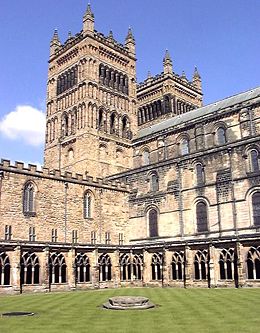Durham Cathedral
2008/9 Schools Wikipedia Selection. Related subjects: Architecture
Durham Cathedral |
|
| Durham Cathedral from across the River Wear | |
| Dedication | Christ, the Blessed Mary the Virgin & St Cuthbert of Durham |
|---|---|
| Denomination | Church of England |
| Tradition | Broad Church |
| Administration | |
| Diocese | Durham |
| Province | Province of York |
| Clergy | |
| Dean | The Very Revd. Michael Sadgrove |
| Canon | The Revd. Prof. Mark McIntosh (from Sep 09) |
| Canon | The Revd. Canon Rosalind Brown |
| Canon | The Revd. Canon Dr Stephen Cherry |
| Precentor | The Revd. Canon Dr David Kennedy |
| Archdeacon | The Ven. Ian Jagger |
| Other | |
| Organist/Director of Music | Canon James Lancelot |
| Organist | Mr Keith Wright |
| Organ Scholar | (position vacant) |
| Chapter Clerk | Mr Paul Whittaker |
| Lay Member of Chapter | Dr David Hunt |
| Lay Member of Chapter | Mr Adrian Beney |
| Website | www.durham cathedral.co.uk |
The Cathedral Church of Christ, Blessed Mary the Virgin and St Cuthbert of Durham, almost always referred to as Durham Cathedral, in the city of Durham, England, was founded in AD 1093 and remains a centre for Christian worship today. It is generally regarded as one of the finest examples of a Norman cathedral in Europe and has been designated a UNESCO World Heritage Site along with nearby Durham Castle, which faces it across Palace Green, high above the River Wear.
The Cathedral houses the shrine and related treasures of Cuthbert of Lindisfarne, a seventh century saint, and these are on public view. It is also home to the head of St Oswald of Northumbria and the remains of the Venerable Bede. One can also climb the 325 steps to the top of the 217 feet (66 m) tall tower to enjoy an outstanding view of Durham and the surrounding area.
There are regular services sung by the cathedral choir. Except for Mondays, and certain vacations, the choir sing every day.
The bishops of Durham were very powerful prince-bishops up to the mid-nineteenth century. The seat of Bishop of Durham is still the fourth most significant in the Church of England hierarchy, and he stands at the right hand of the monarch at coronations. Signposts for the modern day County Durham are nowadays subtitled "Land of the Prince Bishops."
History
Saxon
The see of Durham takes its origins from the Diocese of Lindisfarne, set up by Saint Aidan at the behest of Oswald of Northumbria around AD 635. The see lasted until AD 664, at which point it was translated to York. The see was then reinstated in AD 678 by the Archbishop of Canterbury. The community at Lindisfarne Priory produced many saints, of which Saint Cuthbert is central to the development of Durham Cathedral.
After repeated Viking raids the monks fled Lindisfarne in AD 875, carrying St Cuthbert's relics with them. The diocese of Lindisfarne remained itinerant until 882, when a community was re-established in Chester-le-Street. The see had its seat here until 995, when further incursions once again caused the monks to move with the relics. According to local legend, the monks followed two milk maids who were searching for a dun (i.e. brown) cow and were led into a peninsula formed by a loop in the River Wear. At this point Cuthbert's coffin became immovable and this was taken as sign that the new shrine should be built here. A more prosaic set of reasons for the selection of the peninsula is its highly defensible position, and that a community established here would enjoy the protection of the Earl of Northumberland, as the bishop at this time, Aldhun, had strong family links with the earls. Nevertheless, the street leading from The Bailey past the Cathedral's eastern towers up to Palace Green is named Dun Cow Lane.
Initially, a very simple temporary structure was built from nearby timber to house the relics of Cuthbert. The shrine was then transferred to a sturdier, probably wooden, building known as the White Church. This church was itself replaced three years later in 998 by a stone building also known as the White Church; by 1018 only the west tower was unfinished. Durham soon became a site of pilgrimage, encouraged by the growing cult of Saint Cuthbert. King Canute was one early pilgrim, granting many privileges and much land to the Durham community. The defendable position, flow of money from pilgrims and power embodied in the church at Durham ensured that a town formed around the cathedral, establishing the early core of the modern city.
Medieval
The present cathedral was initially designed and built under the first prince-bishop, William of St. Carilef. Construction began in 1093, although William died before completion of this phase in 1135, passing responsibility to his successor Ranulf Flambard The building is notable for the ribbed vault of the nave roof, with pointed transverse arches supported on relatively slender composite piers alternated with massive drum columns, and flying buttresses or lateral abutments concealed within the triforium over the aisles. These features appear to be precursors of the Gothic architecture of Northern France a few decades later, doubtless due to the Norman stonemasons responsible, although the building is considered Romanesque overall. It was the skilled use of the pointed arch and ribbed vault which made it possible to cover far more elaborate and complicated ground plans than hitherto. The buttressing made it possible both to build taller buildings and to open up the intervening wall spaces to create larger windows.
Saint Cuthbert's tomb lies at the East and was once an elaborate monument of cream marble and gold.
In the twelfth century, Bishop Hugh de Puiset added the Galilee Chapel at the west end of the cathedral. Also known as The Lady Chapel, the Galilee Chapel holds the remains of the Venerable Bede and of Bishop Langley, whose tomb blocked the Great West Door of the cathedral.
William of St. Carilef, Ranulf Flambard, and Hugh de Puiset are all buried in the cathedral's Chapter House, which lies opposite the cloisters and dates from 1140.
The thirteenth century saw the construction of the Chapel of the Nine Altars, at the eastern end of the cathedral, beginning under Richard le Poore (1228-1237). The central tower of this time was destroyed by lightning, so the current tower dates from the fifteenth century.
Dissolution
Cuthbert's tomb was destroyed on the orders of Henry VIII in 1538, but survives as a modest stone affair. Two years later, in 1540, the Benedictine monastery at Durham was dissolved, although the cloisters are well preserved architecturally, and its last prior -- Hugh Whitehead -- became the cathedral's first dean.
The Seventeenth Century
In 1650, Durham Cathedral was used by Cromwell as a makeshift prison to hold Scottish prisoners-of-war after the Battle of Dunbar of September 3, 1650. It is estimated that as many as 3,000 prisoners died in the cathedral itself, where they were kept in inhumane conditions, largely without food, water or heat. The prisoners destroyed much of the cathedral woodwork for firewood but Prior Castell's clock, featuring the Scottish thistle, was spared. Their bodies were buried in unmarked graves. The survivors were shipped as slave labour to North America. In 1946 during work to install a new central heating system at the Cathedral, a mass grave of the Scottish soldiers was uncovered. In 1993 the Scottish Covenanter's Memorials Association discussed with the Cathedral the construction of a memorial to the soldiers, however, this appears to have been inconclusive, since no memorial has yet been created. A campaign properly to respect and remember the "Dunbar Martyrs" was launched at the end of 2007, aiming as a minimum to gain a Christian blessing for the dead and a memorial at the Cathedral burial site or even possible exhumation of the remains and reburial in Scotland.
1700 - 1900
The Chapel of the Nine Altars features a large seventeenth-century rose window, rebuilt in the eighteenth century, and a statue of William Van Mildert, the last prince-bishop (1826-1836) and driving force behind the foundation of Durham University.
20th century and beyond
| Durham Castle and Cathedral* | |
|---|---|
| UNESCO World Heritage Site | |
 |
|
| State Party | |
| Type | Cultural |
| Criteria | ii, iv, vi |
| Reference | 370 |
| Region† | Europe and North America |
| Inscription history | |
| Inscription | 1986 (10th Session) |
| * Name as inscribed on World Heritage List. † Region as classified by UNESCO. |
|
Today, the Cathedral remains the seat of the Bishop of Durham.
In 1986, the Cathedral, together with the nearby Castle, became a World Heritage Site. The UNESCO committee classified the Cathedral under criteria C (ii) (iv) (vi), reporting, "Durham Cathedral is the largest and most perfect monument of 'Norman' style architecture in England".
In 1996 the Great Western Doorway was the setting for Bill Viola's large-scale video installation The Messenger.
Durham Cathedral has been featured in the Harry Potter films as Hogwarts School of Witchcraft and Wizardry, where it had a spire digitally added onto the top of the famous towers.
Interior views of the Cathedral were featured in the 1998 film Elizabeth.
Architectural historian Dan Cruickshank selected the Cathedral as one of his four choices for the 2002 BBC television documentary series Britain's Best Buildings.
Organ and Organists
Organ
Details of the organ from the National Pipe Organ Register
Organists
|
|
Quotations
"Durham is one of the great experiences of Europe to the eyes of those who appreciate architecture, and to the minds of those who understand architecture. The group of Cathedral, Castle, and Monastery on the rock can only be compared to Avignon and Prague." - Sir Nikolaus Pevsner, The Buildings of England.
'With the cathedral at Durham we reach the incomparable masterpiece of Romanesque architecture not only in England but anywhere. The moment of entering provides for an architectural experience never to be forgotten, one of the greatest England has to offer.' Alec Clifton-Taylor 'English Towns' series on BBC television.
"I paused upon the bridge, and admired and wondered at the beauty and glory of this scene...it was grand, venerable, and sweet, all at once; I never saw so lovely and magnificent a scene, nor, being content with this, do I care to see a better." - Nathaniel Hawthorne on Durham Cathedral, The English Notebooks.
"I unhesitatingly gave Durham my vote for best cathedral on planet Earth." - Bill Bryson, Notes from a Small Island.
- "Grey towers of Durham
- Yet well I love thy mixed and massive piles
- Half church of God, half castle 'gainst the Scot
- And long to roam those venerable aisles
- With records stored of deeds long since forgot."
- Yet well I love thy mixed and massive piles
- Sir Walter Scott, Harold the Dauntless, a poem of Saxons and Vikings set in County Durham.

